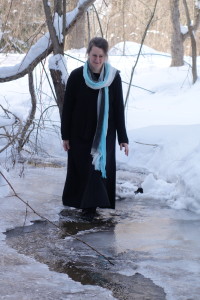
Charles Dickens walked at night, roaming the streets of London to work on plot lines.
Mark Twain paced.
J.K. Rowling stated: “Nothing like a nighttime stroll to give you ideas.”
Hemmingway also walked to think through his stories.
Is there a connection between walking and sparking creativity?
When you walk, you allow your conscious mind to access new ideas in the subconscious. For most of us, walking doesn’t take a lot of thought but does get our body moving and allows our mind to meander at the same time as our feet are wandering.
I recently listened to a radio program interviewing Eric Weiner about his new book, “The Geography of Genius”. Disclaimer: I haven’t read the book, but I was curious enough about his idea to read online reviews, on which I based the following. I gather that his thesis is something about geography – in his theory, urban centres – being important to producing works of genius. He claims that genius thrives in chaos: in terms of geography, that means, cities. Urban centres abound with chaos as anyone from Grey and Bruce Counties knows when we try to navigate Toronto traffic. He points to historical genius figures who lived in cities, such as Mozart’s Vienna, and the Greek philosophers in Athens.
Part of his theory is that there is connection between geography and walking. Apparently Steve Jobs was known for having “walking meetings”. Aristotle conducted his lectures to his followers by walking around Athens. Many famous writers walked a lot. Someone actually calculated that William Wordsworth walked an average of six and a half miles a day starting from the age of five (based on an estimated 180 000 miles he walked in his lifetime).

I guess Eric Weiner concludes that if you live in rural area, you don’t walk enough. Or if you do walk, it’s too peaceful to be stimulating (or chaotic). Therefore, I suggest that we, rural writers, walk at night through the deep forest, in fear of the wild beasts (real or imagined) that troll the countryside. Since E.W. also thinks that creativity is sparked by some degree of hardship, we perhaps should allow ourselves to be attacked by such wild beasts, barely surviving, to drag ourselves back to the safety of the log cabin to pen that masterpiece.
Standford University did a study that found that people on treadmills produce more creative ideas than if you’re sitting down… and by an average of 60%! And it doesn’t matter if you walk on a treadmill looking at a blank wall or if you walk outside in fresh air (although they didn’t factor in walking at night among the wild beasts).
Even a 5 minute walk can boost creativity.
I recently read about a theory of the brain that states that the brain operates on the edge of chaos. The analogy used is of sand running through an hourglass. The sand on the bottom half builds in a pyramid shape in an outwardly orderly fashion. This is order. However, any additional falling grain of sand might cause an avalanche – chaos – to this nicely, ordered pyramid. This is referred to being on the edge between order and chaos. Our brain, working at this edge of chaos, may be connected to how our memory works. Could it also explain those leaps of creativity that seemingly magically appear to writers and artists?
Imagine that you’re working on your great novel. You have an outline, strong yet flawed characters, and have worked diligently, chapter after chapter. Then you get stuck or a problem arises. You don’t know how to get your character out of the pit that you’ve thrown the poor soul into to test him. You go for a walk. Preferably at night and in the deep woods. Among the wild beasts.
Keep walking.
Don’t worry that you’re not writing. Charles Dickens sometimes walked for 20 to 30 miles a day. And he still wrote an incredible number of words that formed great novels and short stories that people still read today. That grain of sand is coming. It will send a ripple down the pyramid in your brain and suddenly you have a new idea. The pit has a hole – your character escapes to survive into the next chapter.
If you’re not writing, maybe you should be walking.